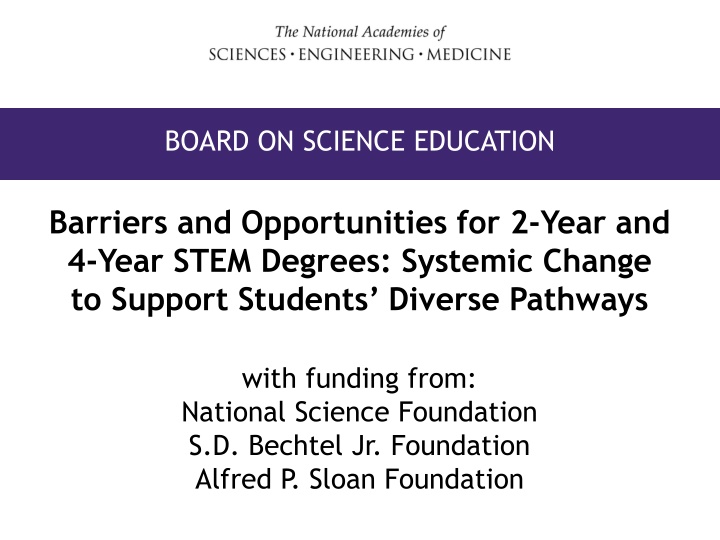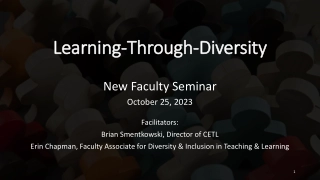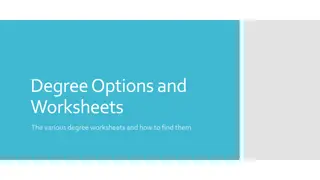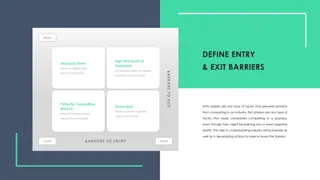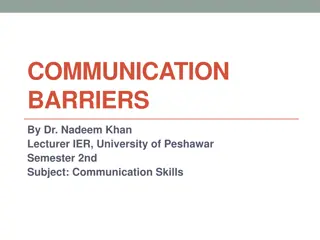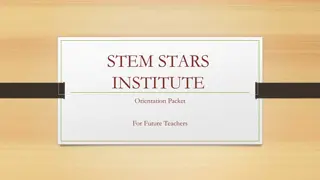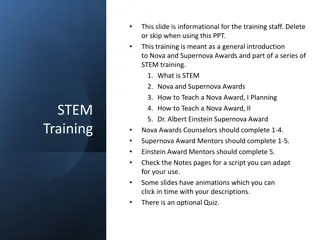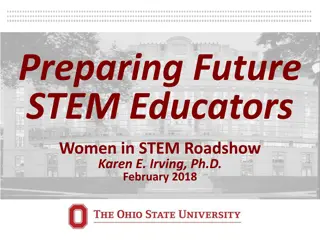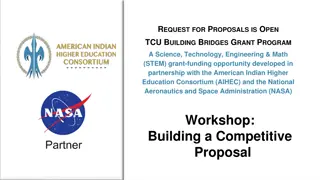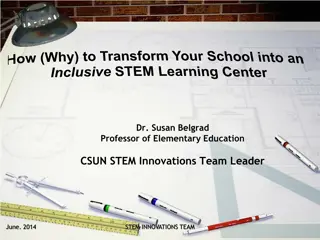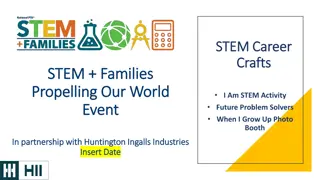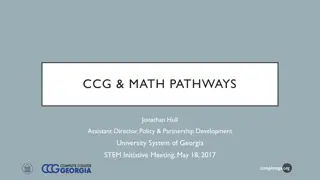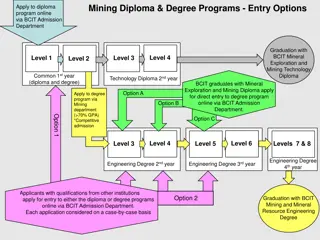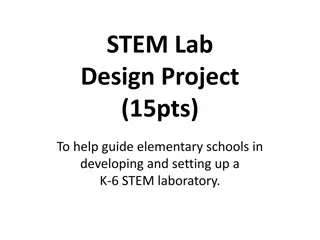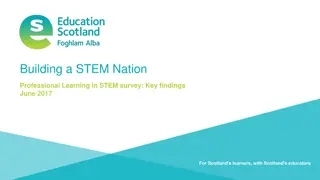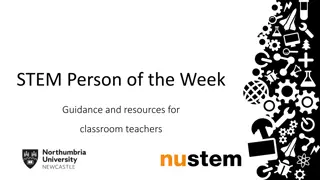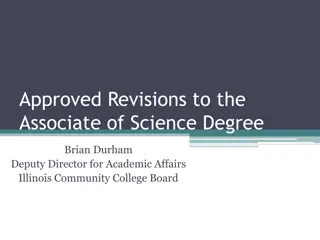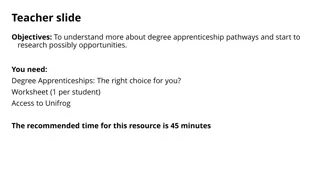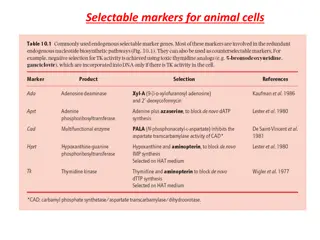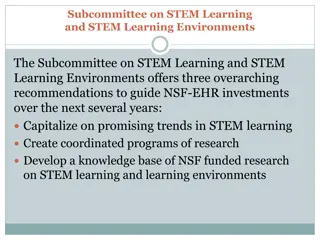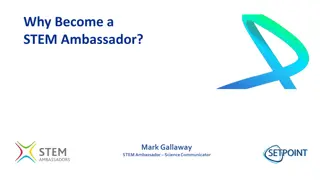Enhancing STEM Degree Completion: Barriers, Opportunities, and Solutions
Reviewing barriers faced by undergraduates intending to major in STEM and exploring opportunities to overcome these challenges. Providing research-based guidance to support diverse pathways in completing STEM degrees.
Download Presentation

Please find below an Image/Link to download the presentation.
The content on the website is provided AS IS for your information and personal use only. It may not be sold, licensed, or shared on other websites without obtaining consent from the author.If you encounter any issues during the download, it is possible that the publisher has removed the file from their server.
You are allowed to download the files provided on this website for personal or commercial use, subject to the condition that they are used lawfully. All files are the property of their respective owners.
The content on the website is provided AS IS for your information and personal use only. It may not be sold, licensed, or shared on other websites without obtaining consent from the author.
E N D
Presentation Transcript
BOARD ON SCIENCE EDUCATION WATER SCIENCE AND TECHNOLOGY BOARD Barriers and Opportunities for 2-Year and 4-Year STEM Degrees: Systemic Change to Support Students Diverse Pathways with funding from: National Science Foundation S.D. Bechtel Jr. Foundation BOARD ON SCIENCE EDUCATION Alfred P. Sloan Foundation
Study Charge Review evidence related to barriers facing 2- and 4-year undergraduates who intend to major in STEM and opportunities for overcoming these barriers. Provide research-based guidance to inform policies and programs aimed to attract and retain students to complete associate s and bachelor s degrees in STEM disciplines. BOARD ON SCIENCE EDUCATION
Related Reports www.nap.edu BOARD ON SCIENCE EDUCATION
Committee Shirley Malcom (Chair), American Association for the Advancement of Science Cynthia Atman, Center for Engineering Learning and Teaching, University of Washington George Boggs, American Association of Community Colleges (emeritus) Pamela Brown, Office of the Provost, New York City College of Technology, City University of New York Peter Bruns, Howard Hughes Medical Institute (emeritus) Tabbye Chavous, Departments of Psychology and Educational Studies, University of Michigan Charles De Leone, Department of Physics, California State University, San Marcos Frank Dobbin, Department of Sociology, Harvard University S. James Gates,Jr., Department of Physics, University of Maryland BOARD ON SCIENCE EDUCATION
Sylvia Hurtado, Graduate School of Education and Information Studies, University of California, Los Angeles Leah H. Jamieson, College of Engineering, Purdue University Adrianna Kezar, Pullias Center for Higher Education, University of Southern California Kenneth Koedinger, Human-Computer Interaction Institute, Carnegie Mellon University Muriel Poston, Dean of Faulty, Pitzer College Mark Rosenberg, President, Florida International University Uri Treisman, Charles A. Dana Center for Mathematics and Science Education, University of Texas, Austin Michelle Van Noy, Education and Employment Research Center, Rutgers University X. Ben Wu, Department of Ecosystem Science and Management, Texas A&M University BOARD ON SCIENCE EDUCATION
Major Topics (Chapters) Multiple STEM Pathways Why students enter, stay, or leave the culture of undergraduate STEM education Instructional practices, departmental leadership, and co-curricular supports Why students stay or leave institutional, state, and national policies Leading and sustaining change BOARD ON SCIENCE EDUCATION
Make-up of student body not the same as 25 years ago Student Characteristics 1987 2012 Aged 25 and Older Enrolled in 2-Year Institutions Enrolled Part Time Minority Employed Part-Time Employed Full-Time Parents Single Parent Women 37 43 42 20 40 40 50 42 40 27 26 15 57 * 26 20 7 54 Students more likely to be from minority groups and be single parents. BOARD ON SCIENCE EDUCATION
Students taking more complex pathways 2-Year Institutions 4-Year Institutions Often transfer among institutions Enter & exit at different phases of study Concurrently enroll at more than one institution All Science & Eng Non- STEM Non- STEM STEM Tech STEM Enrollment Patterns Average Enrollment Intensity Always Full Time Always Part Time Mixed Part Time and Full Time Constancy of Attendance/Number of Stopouts 0 1 2+ Institutional Attendance Attend Only One Institution Traditional Transfer Attend Multiple Institutions, Swirling 33 13 36 8 32 15 27 22 68 1 65 2 53 55 53 51 31 33 47 41 12 49 43 8 46 39 15 50 35 15 71 22 7 72 21 7 49 25 33 41 59 16 62 19 75 NA 74 NA 26 26 25 19 25 26 BOARD ON SCIENCE EDUCATION
Cumulative percentage of 2004 STEM aspirants who completed STEM degrees in 4, 5, and 6 years On-time completion of credential is infrequent: only 22% of students aspiring to 4-year STEM degree achieve their goal. Source: Eagan et al., 2014 (Fig 7) BOARD ON SCIENCE EDUCATION
Todays STEM Students CONCLUSION 1 There is an opportunity to expand and diversify the nation s STEM workforce and STEM-skilled workers in all fields if there is a commitment to appropriately support students through degree completion and provide more opportunities to engage in high-quality STEM learning and experiences. CONCLUSION 2 STEM aspirants increasingly navigate the undergraduate education system in new and complex ways. It takes students longer for completion of degrees, there are many patterns of student mobility within and across institutions, and the accommodation and management of student enrollment patterns can affect how quickly and even whether a student earns a STEM degree. BOARD ON SCIENCE EDUCATION
Todays STEM Students CONCLUSION 3 National, state, and institutional undergraduate data systems often are not structured to gather information needed to understand how well the undergraduate education system and institutions of higher education are serving students. BOARD ON SCIENCE EDUCATION
Todays STEM Students RECOMMENDATION 1 Data collection systems should be adjusted to collect information to help departments and institutions better understand the nature of the student populations they serve and the pathways these students take to complete STEM degrees. BOARD ON SCIENCE EDUCATION
Todays STEM Students RECOMMENDATION 2 Federal agencies, foundations, and other entities that fund research in undergraduate STEM education should prioritize research to assess whether enrollment mobility in STEM is a response to financial, institutional, individual, or other factors, both individually and collectively, and to improve understanding of how student progress in STEM, in comparison with other disciplines, is affected by enrollment mobility. BOARD ON SCIENCE EDUCATION
STEM Culture: Students Culture of STEM has effect on students interest, self-concept, sense of connectedness, & persistence. New research is needed to understand whether STEM gateway courses continue to negatively impact STEM student persistence due to culture of classrooms. BOARD ON SCIENCE EDUCATION
STEM Culture: Institutional Adoption of reformed curriculum and teaching practices remains difficult because of barriers at multiple levels. Departments are a critical unit for change. Co-curricular supports can provide authentic disciplinary experiences and attend to social-relational aspects of learning influencing student outcomes. BOARD ON SCIENCE EDUCATION
Institutional Support for Students CONCLUSION 4 Better alignment of STEM programs, instructional practices, and student supports is needed in institutions to meet the needs of the populations they serve. Programming and policies that address the climate of STEM departments and classrooms, the availability of instructional supports and authentic STEM experiences, and the implementation of effective teaching practices together can help students overcome key barriers to earning a STEM degree, including the time to degree and the price of a STEM degree. BOARD ON SCIENCE EDUCATION
Institutional Support for Students RECOMMENDATION 3 Federal agencies, foundations, and other entities that support research in undergraduate STEM education should support studies with multiple methodologies and approaches to better understand the effectiveness of various co-curricular programs. BOARD ON SCIENCE EDUCATION
Institutional Support for Students RECOMMENDATION 4 Institutions, states, and federal policy makers should better align educational policies with the range of education goals of students enrolled in 2- and 4- year institutions. Policies should account for the fact that many students take more than 6 years to graduate and should reward 2- and 4-year institutions for their contributions to the educational success of students they serve, which includes not only those who graduate. BOARD ON SCIENCE EDUCATION
Institutional Support for Students RECOMMENDATION 5 Institutions of higher education, disciplinary societies, foundations, and federal agencies that fund undergraduate education should focus their efforts in a coordinated manner on critical issues to support STEM strategies, programs, and policies that can improve STEM instruction. BOARD ON SCIENCE EDUCATION
Why Students Stay or Leave: Debt On average, price students pay for STEM degree is higher than price of non-STEM degree. STEM degrees in orange. BOARD ON SCIENCE EDUCATION
Percentage of all undergraduate STEM students with various debt levels by type of institution Source: Kirshtein, 2013c (p1) BOARD ON SCIENCE EDUCATION
Undergraduate debt in STEM by minority status Underrepresented students graduate with debt > $30,000 especially at Private Bachelor s In all private institutions, non- underrepresented students more likely to be debt free Source: Kirshtein, 2013c (p2) BOARD ON SCIENCE EDUCATION
Institutional Support for Students RECOMMENDATION 6 Accrediting agencies, states, and institutions should take steps to support increased alignment of policies that can improve the transfer process for students. RECOMMENDATION 7 State and federal agencies and accrediting bodies together should explore the efficacy and tradeoffs of different articulation agreements and transfer policies. BOARD ON SCIENCE EDUCATION
Systemic and Sustainable Change in STEM Education CONCLUSION 5 There is no single approach that will improve the educational outcomes of all STEM aspirants. The nature of U.S. undergraduate STEM education will require a series of interconnected and evidence-based approaches to create systemic organizational change for student success. BOARD ON SCIENCE EDUCATION
Systemic and Sustainable Change in STEM Education CONCLUSION 6 Improving undergraduate STEM education for all students will require a more systemic approach to change that includes use of evidence to support institutional decisions, learning communities and faculty development networks, and partnerships across the education system. BOARD ON SCIENCE EDUCATION
Systemic and Sustainable Change in STEM Education RECOMMENDATION 8 Institutions should consider how expanded and improved co-curricular supports for STEM students can be informed by and integrated into work on more systemic reforms in undergraduate STEM education to more equitably serve their student populations. RECOMMENDATION 9 Disciplinary departments, institutions, university associations, disciplinary societies, federal agencies, and accrediting bodies should work together to support systemic and long-lasting changes to undergraduate STEM education. BOARD ON SCIENCE EDUCATION
BOARD ON SCIENCE EDUCATION WATER SCIENCE AND TECHNOLOGY BOARD Barriers and Opportunities for 2-Year and 4-Year STEM Degrees: Systemic Change to Support Students Diverse Pathways with funding from: National Science Foundation S.D. Bechtel Jr. Foundation BOARD ON SCIENCE EDUCATION Alfred P. Sloan Foundation
Extra Slides BOARD ON SCIENCE EDUCATION
Degrees awarded in 2012 in STEM fields in Public, Private Nonprofit, and Private For-Profit Institutions Source: Kinser, 2014 BOARD ON SCIENCE EDUCATION
STEM degrees in 2012 from Public, Private Nonprofit, and Private For-Profit, by students race and ethnicity Source: Kinser, 2014 BOARD ON SCIENCE EDUCATION
